Did you know a Philodendron ‘Lemon Lime’ can grow up to almost 12 feet long? These plants are easy to care for and perfect for beginners. The Philodendron Narrow has slender leaves that fit well in many homes. This guide will give you tips to keep your Philodendron Narrow healthy and beautiful.
Key Takeaways
- Philodendron Narrow is a popular and easy-to-care-for indoor plant with unique foliage
- These plants thrive in bright, indirect light and require proper watering to prevent issues
- Philodendrons prefer warm temperatures and high humidity, mimicking their tropical rainforest origins
- Well-draining soil and balanced fertilization are essential for healthy growth
- Regular pruning and cleaning can help maintain the Philodendron Narrow’s attractive appearance
Introduction to Philodendron Narrow
Description and Origins
The Philodendron Narrow is a beautiful tropical plant from Central and South America’s lush rainforests. It belongs to the Araceae family. This plant is loved for its long, narrow leaves that can grow up to 3 feet long. Unlike wild Philodendrons, the Narrow variety is a hybrid, bred for its elegant look.
Unique Features and Appeal
This plant stands out with its unique leaf shape and how it grows. Its leaves are deep green, glossy, and long, adding a tropical feel to any room. You can hang it in baskets or let it trail along shelves or furniture.
People love the Philodendron Narrow for how easy it is to care for. Its beautiful look and ability to fit well indoors have made it popular in homes and offices. It’s great for improving the indoor plant aesthetics.
“The Philodendron Narrow’s unique leaf shape and growth habit make it a true standout among indoor plants, adding a touch of tropical elegance to any living space.”
Whether you’re new to plants or have been growing them for years, the Philodendron Narrow is a great choice. It can make your indoor decor look better and is easy to take care of. It’s perfect for those interested in philodendron narrow appeal, philodendron narrow features, and philodendron narrow description.
Lighting Requirements for Philodendron Narrow
Philodendron Narrow plants do well in bright, indirect light. Place them near a window to get filtered sunlight all day. But, keep them away from direct afternoon sun to prevent damage to their leaves.
These plants can handle low light, but they might get long and have small leaves. Bright indirect light is crucial for a healthy Philodendron Narrow.
Here are some tips for the best lighting:
- Put the Philodendron Narrow by a north- or east-facing window for bright indirect light.
- Don’t let it get direct sunlight, especially in the hottest part of the day, as it can burn the leaves.
- If your home lacks good natural light, use indoor plant lighting to make sure your Philodendron Narrow gets enough bright indirect light.
“Philodendrons, including the Philodendron Narrow variety, are known for cleaning the air, making homes and offices healthier.”
Give your Philodendron Narrow the right philodendron narrow lighting for it to flourish. The key is finding the right mix of bright indirect light and protection from direct sun. This will keep your Philodendron Narrow looking great and healthy.
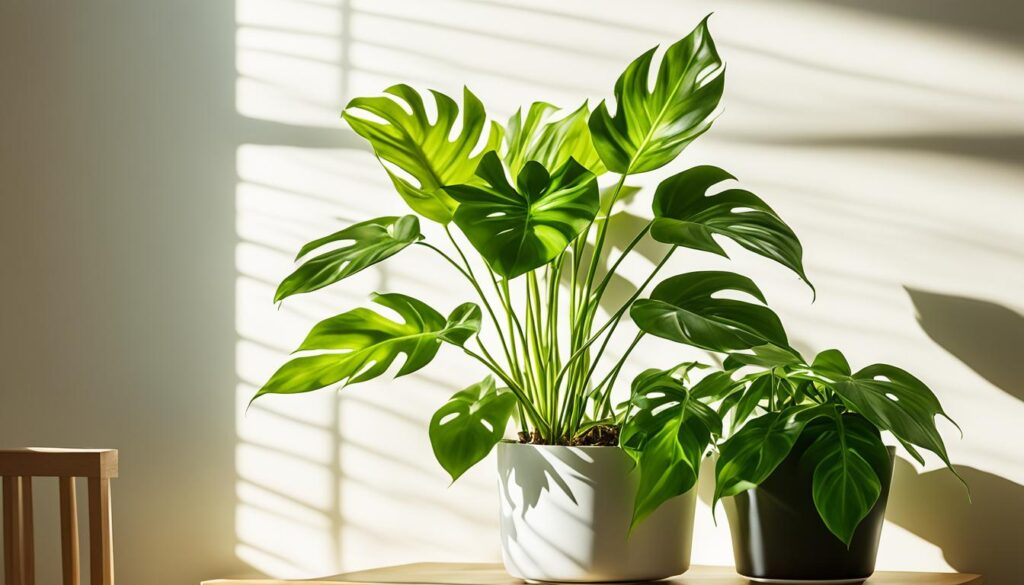
Watering Needs and Techniques
Proper philodendron narrow watering is key for your indoor plant’s health and life. Water your Philodendron Narrow when the top inch of soil feels dry. Avoid letting the soil dry out completely. Overwatering can cause yellow leaves and root rot. On the other hand, underwatering makes leaves wilt, curl, or wrinkle.
To keep your Philodendron Narrow healthy, water it every 1-2 weeks. Let the soil dry out a bit between waterings. The watering schedule might change with your home’s light, temperature, and humidity. A consistent watering routine is vital for your Philodendron Narrow’s happiness and growth.
Signs of Overwatering and Underwatering
- Overwatering: Yellowing leaves, wilting, and potential root rot
- Underwatering: Wilting, curling, or wrinkling leaves
Proper Watering Schedule
- Water your Philodendron Narrow every 1-2 weeks, letting the soil dry out a bit between.
- Change the watering frequency as needed, based on your home’s light, temperature, and humidity.
- Make sure the pot has good drainage to avoid overwatering and root rot.
“Consistent philodendron narrow watering is key to maintaining a healthy, thriving indoor plant.”
https://www.youtube.com/watch?v=UJ7xpR8WFaU
Temperature and Humidity Preferences
The Philodendron Narrow needs the right temperature and humidity to grow well. It likes warm temperatures between 65°F and 85°F (18°C – 29°C). Keep the plant away from drafts and sudden temperature changes to avoid stress.
This plant also loves high humidity, like its rainforest home. Mist the leaves or put the plant on a pebble tray with water to keep it moist. Use a hygrometer to check humidity levels and adjust your care as needed.
“Night temperatures of 65 to 70 °F and day temperatures of 75 to 85 °F are ideal for most philodendrons.”
Low humidity from dry air, often in winter, can harm the Philodendron Narrow. In summer, you might need to adjust your care to keep moisture levels right. Watch the plant and adjust the humidity to keep it healthy.
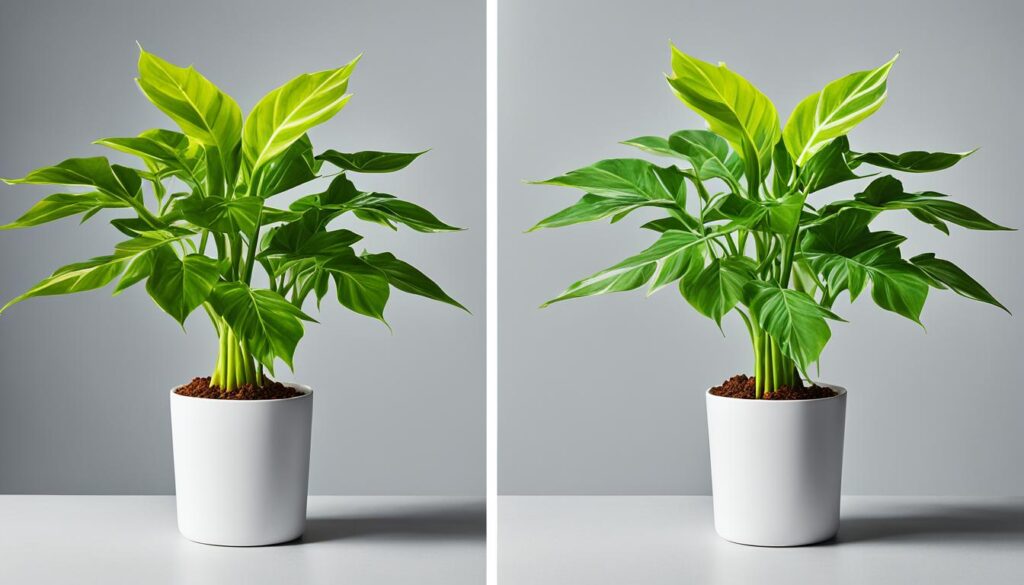
The Philodendron Narrow is a tropical plant that loves warmth and humidity. Give it the right temperature and humidity, and it will grow strong and colorful.
Soil Mix and Potting
Choosing the right soil mix is key for your Philodendron Narrow’s health and growth. These plants do well in soil that drains well and is a bit acidic, with a pH of 5.0 to 6.0. A mix of peat moss, perlite, and vermiculite, or a store-bought houseplant potting mix, is perfect for them.
Well-Draining Soil Composition
Your Philodendron Narrow needs soil that’s loose and full of air pockets, so water can drain easily. Stay away from dense soils that can cause waterlogging and root rot. A mix of 3 parts all-purpose potting soil, 2 parts coarse sand or grit, and 1 part perlite works great. This mix keeps the soil moist but also ensures good drainage, which is key for your plant’s health.
Repotting Tips
Philodendron Narrow plants might need a new pot every 1-2 years as they grow. When you repot, pick a pot just a bit bigger than the old one. Philodendrons like to have their roots a bit cramped. Carefully take the plant out of its old pot without hurting the roots, and put it in a new container with fresh, well-draining potting mix. This way, your plant will keep doing well and stay the right size.
By choosing the right soil mix and repotting your Philodendron Narrow correctly, you’ll keep it healthy and beautiful. It will add elegance to your indoor space.
Fertilizing Philodendron Narrow
Proper fertilization is key to keeping your Philodendron Narrow lush and vibrant. These plants do well with a balanced philodendron narrow fertilizer in spring and summer. This is when they grow the most.
For your Philodendron Narrow, use a balanced, water-soluble indoor plant fertilizer. Put the fertilizer on every 2 to 4 weeks. But, make sure to dilute it to half the strength to prevent too much fertilizer.
This way, your plant gets the nutrients it needs without harm. It’s a gentle way to feed your plant.
Don’t fertilize your Philodendron Narrow in winter. This is when the plant grows less and needs less water and no extra fertilizer. It stays healthy just by resting.
“Using a balanced fertilizer and following a consistent feeding schedule is crucial for the long-term success of your Philodendron Narrow.”
Give your Philodendron Narrow the right philodendron narrow fertilizer and feeding schedule. This will help it grow lush and vibrant. It will be a beautiful part of your indoor space.
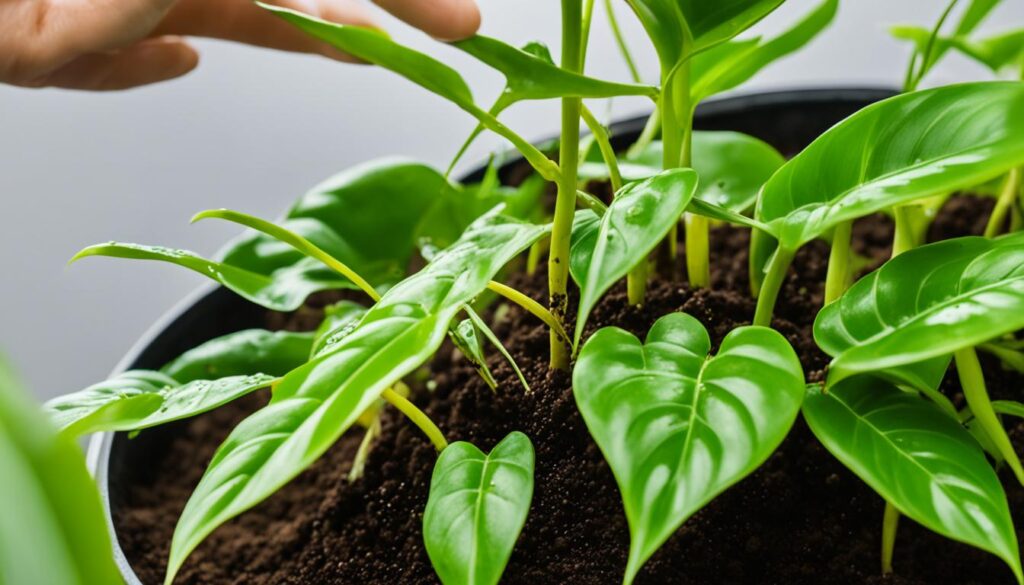
Pruning and Maintenance
To keep your Philodendron Narrow plant looking great, you need to prune and clean its leaves regularly. By following simple steps, your indoor plant will stay healthy and look good.
Trimming and Shaping
Trimming your Philodendron Narrow now and then helps keep its shape and makes it bushier. Use sharp scissors or pruners to cut off dead, damaged, or ugly leaves and stems. Then, trim back any long vines to the right length, cutting just above a leaf node to encourage new growth.
Cleaning Leaves
Cleaning your Philodendron Narrow’s leaves often keeps them shiny and bright. Use a damp cloth or a special plant leaf maintenance product for houseplant care. This keeps dust and dirt away, making your plant look its best.
“Proper plant maintenance is key to ensuring your Philodendron Narrow thrives indoors for years to come.”
Adding philodendron narrow pruning and leaf cleaning to your routine will keep your Philodendron Narrow looking great. With a bit of care, this beautiful indoor plant will brighten your space for many years.
Common Pests and Diseases
The Philodendron Narrow is usually tough and healthy indoors. But, it can face pests and diseases sometimes. Checking your plant often and acting fast can keep it healthy and strong.
Identifying and Treating Infestations
Mealybugs, spider mites, and scale insects often bother philodendron narrow plants. These pests eat the leaves and stems, causing color changes, slow growth, and sometimes death.
To spot and fix pest problems, look closely at the plant, especially under leaves and where leaves meet stems. If pests are there, deal with them fast. Insecticidal soaps or neem oil work well against these pests.
Preventing Future Issues
Good plant pest control and disease prevention keep your philodendron narrow healthy. Make sure it gets the right lighting, watering, and humidity. Plants under stress are more likely to get pests and diseases.
- Don’t crowd plants together, as this can spread pests and diseases.
- Keep new plants separate to stop pests and diseases from spreading.
- Clean the plant’s leaves often to remove dust and pests.
By watching closely and acting early, you can stop philodendron narrow pests or diseases. This keeps your plant looking great and healthy indoors.
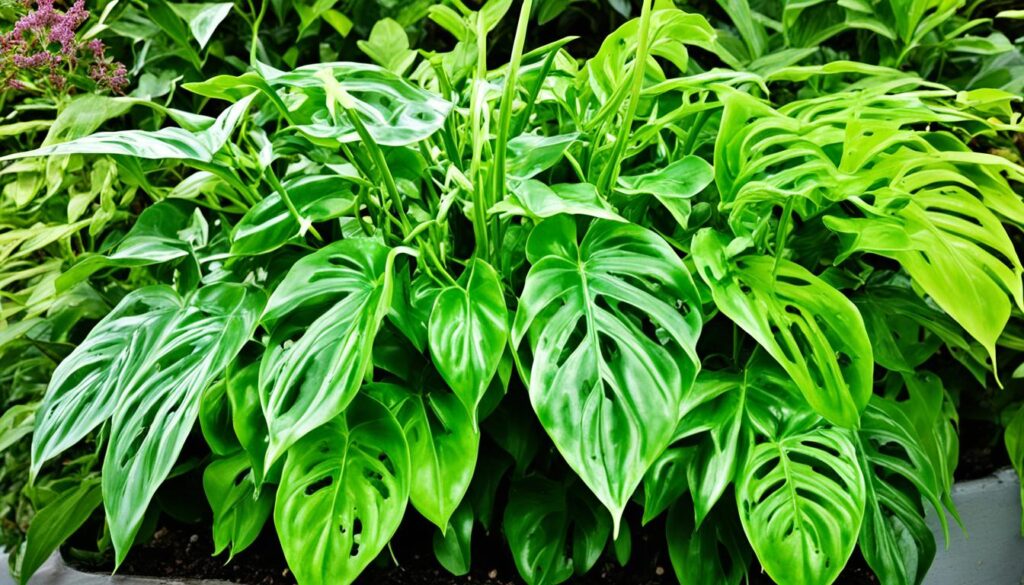
Philodendron Narrow Varieties and Cultivars
The Philodendron Narrow is a standout variety, but there are more to explore for indoor plant lovers. These varieties come with different leaf patterns and growth styles. They offer many choices for various indoor settings and personal tastes.
The Philodendron Brasil has heart-shaped leaves with green and yellow patterns. The Philodendron Birkin shows off white and yellow stripes. And the Philodendron Pink Princess is famous for its pink leaves.
There are many more Philodendron types, each with its own look. You might like the Philodendron tortum with its fern-like leaves or the Philodendron micans with soft, textured leaves. For those who love bold colors, the Philodendron Rojo Congo is a great choice. Or if you prefer something more subtle, the Philodendron brandtianum has beautiful silver stripes.
When picking a Philodendron, think about the leaf color, size, how it grows, and what light it needs. Some do well in low light, while others like bright, indirect sunlight. Knowing what each variety needs helps you take good care of it and enjoy its beauty indoors.
The wide range of Philodendron types means there’s something for everyone. Whether you’re an experienced plant collector or just starting, the Philodendron family has something special to offer. These plants are not only beautiful but also clean the air, making them great for homes and offices.
Propagation Techniques
Propagating your Philodendron Narrow plants is a great way to grow your indoor plant collection. You can easily multiply them using stem cuttings and air layering. Let’s dive into these philodendron narrow propagation methods.
Stem Cuttings
Stem cuttings are a popular way to grow more philodendrons. First, pick a healthy stem and cut off a 4-6 inch piece. Make sure it has at least one leaf node. Let the cutting dry out for a day or two before planting it in good soil.
Keep the soil moist, and roots should start to grow in a few weeks.
Air Layering
Philodendron narrow air layering is another great way to grow new plants. This method involves making a small wound on a stem, covering it with damp moss, and sealing it in a plastic bag or using rooting hormone. This encourages root growth.
Once roots have formed, you can cut the stem and plant it as a new Philodendron Narrow plant.
Both stem cuttings and air layering are easy and effective ways to grow more Philodendron Narrow plants. With patience and proper care, you can fill your home with these beautiful plants.

Toxicity and Pet Safety
When caring for the Philodendron Narrow, knowing about its toxicity is key. This plant has parts that can be harmful if eaten by humans or pets.
The philodendron narrow toxicity can cause mouth pain, throwing up, and stomach upset. So, it’s important to keep it away from philodendron narrow pets and kids. This ensures indoor plant safety.
- The Philodendron Narrow is toxic to humans and pets.
- Eating any part of the plant can cause mouth pain, burning, and stomach problems.
- Keep the plant away from pets and kids to stop them from eating it by mistake.
“Philodendrons are a common household plant, but their toxicity is often overlooked. Proper precautions are necessary to protect your loved ones.”
If you have kids or pets at home, pick safe plants instead. With some extra care, you can make a beautiful, pet-friendly indoor space for everyone.
Decorating with Philodendron Narrow
The Philodendron Narrow’s trailing habit and elegant foliage make it perfect for indoor plant decor. Its long, slender leaves can be shown in many ways. This makes it a beautiful addition to any room.
Container and Potting Options
Think about putting your Philodendron Narrow in a hanging basket or a decorative container that matches the plant’s look. You can also train it to climb up a trellis or moss pole. This adds height to your indoor plant display.
Ideal Placement and Display
Choose a spot for your Philodendron Narrow that gets bright, indirect light, like near a window or under a skylight. You can let its leaves cascade from a high shelf or mantel. Or, place it on a plant stand to make it stand out. Try different setups to see what looks best for your Philodendron Narrow.
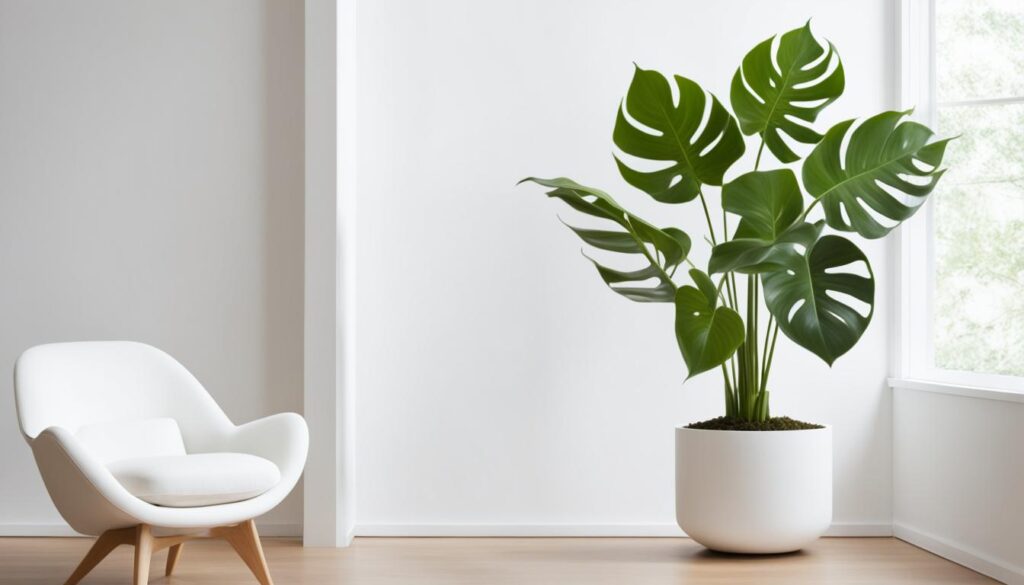
“The Philodendron Narrow’s trailing habit and elegant foliage make it a stunning addition to any indoor space.”
Using the Philodendron Narrow in your decor adds a touch of indoor plant styling that’s both useful and pretty. By thinking about the plant’s special features and trying out different ways to display it, you can make a lovely and striking indoor plant display.
Troubleshooting Common Problems
Philodendron Narrow plants are known for their beautiful leaves. But, they can face issues like yellowing leaves, wilting, and losing their variegation. These problems can be fixed with some care adjustments. Your Philodendron Narrow can recover and thrive again.
Yellowing leaves are a common problem. They can be caused by too much water, not enough nutrients, too much sun, or pests like spider mites. To fix this, check the soil moisture and adjust your watering. Make sure your plant gets enough light and consider fertilizing it.
Wilting or drooping leaves mean your plant might be underwatered, in low humidity, or stressed by temperature changes. Keep the soil moist but not too wet. Consider putting your Philodendron Narrow in a humid spot, like near a pebble tray or humidifier.
Loss of variegation, or the lack of leaf patterns, can happen if the plant doesn’t get enough light. Move your Philodendron Narrow to a brighter spot. But, don’t put it in direct sunlight, as it can burn the leaves.
By watching your plant closely and fixing these issues quickly, you can keep your Philodendron Narrow healthy. Each plant is different, so you might need to try a few things to find what works best for yours.
“With a little patience and the right adjustments, your Philodendron Narrow can overcome even the trickiest indoor plant issues.”
Conclusion
The Philodendron Narrow is a beautiful indoor plant that can make any room look better. With the right care, like proper lighting, watering, and soil, it can bring lush, tropical beauty to your home for many years.
It’s perfect for both plant experts and beginners. The Philodendron Narrow fits well in many homes with its elegant leaves and simple care. It’s a great choice for anyone looking to add to their indoor plants.
Let the Philodendron Narrow add beauty and calm to your home. With the right care, it will keep its vibrant look and charm for years. Enjoy the beauty of this amazing indoor plant in your space.


